Australian Hotel & Hospitality: Disruptive Technology Analysis Report
VerifiedAdded on 2023/06/10
|10
|2570
|97
Report
AI Summary
This report delves into the transformative impact of disruptive technologies on the Australian hotel and hospitality industry. It meticulously examines the influence of innovations such as robot facilities and Near Field Communication (NFC) on the sector. The report analyzes the positive and negative impacts of these technologies, including how they affect customer satisfaction, operational efficiency, and employment. Furthermore, it explores the evolving role of disruptive innovation in enhancing customer experiences and driving business growth. The report also forecasts future trends, such as the integration of human-robot interaction, infrared scanners, and virtual reality to enhance services. The conclusion emphasizes the importance of embracing technological advancements for sustained competitiveness and customer satisfaction within the dynamic hospitality sector.
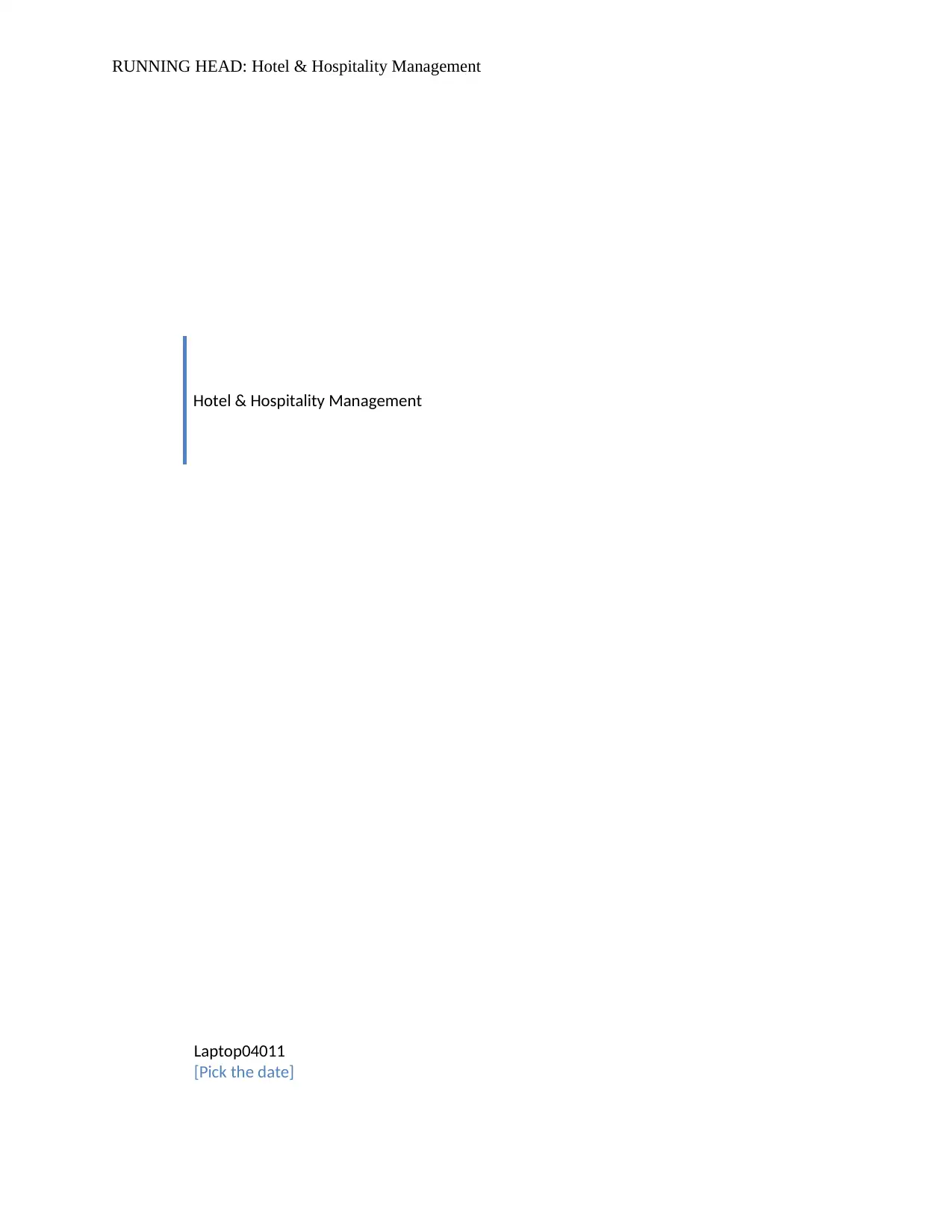
RUNNING HEAD: Hotel & Hospitality Management
Hotel & Hospitality Management
Laptop04011
[Pick the date]
Hotel & Hospitality Management
Laptop04011
[Pick the date]
Paraphrase This Document
Need a fresh take? Get an instant paraphrase of this document with our AI Paraphraser
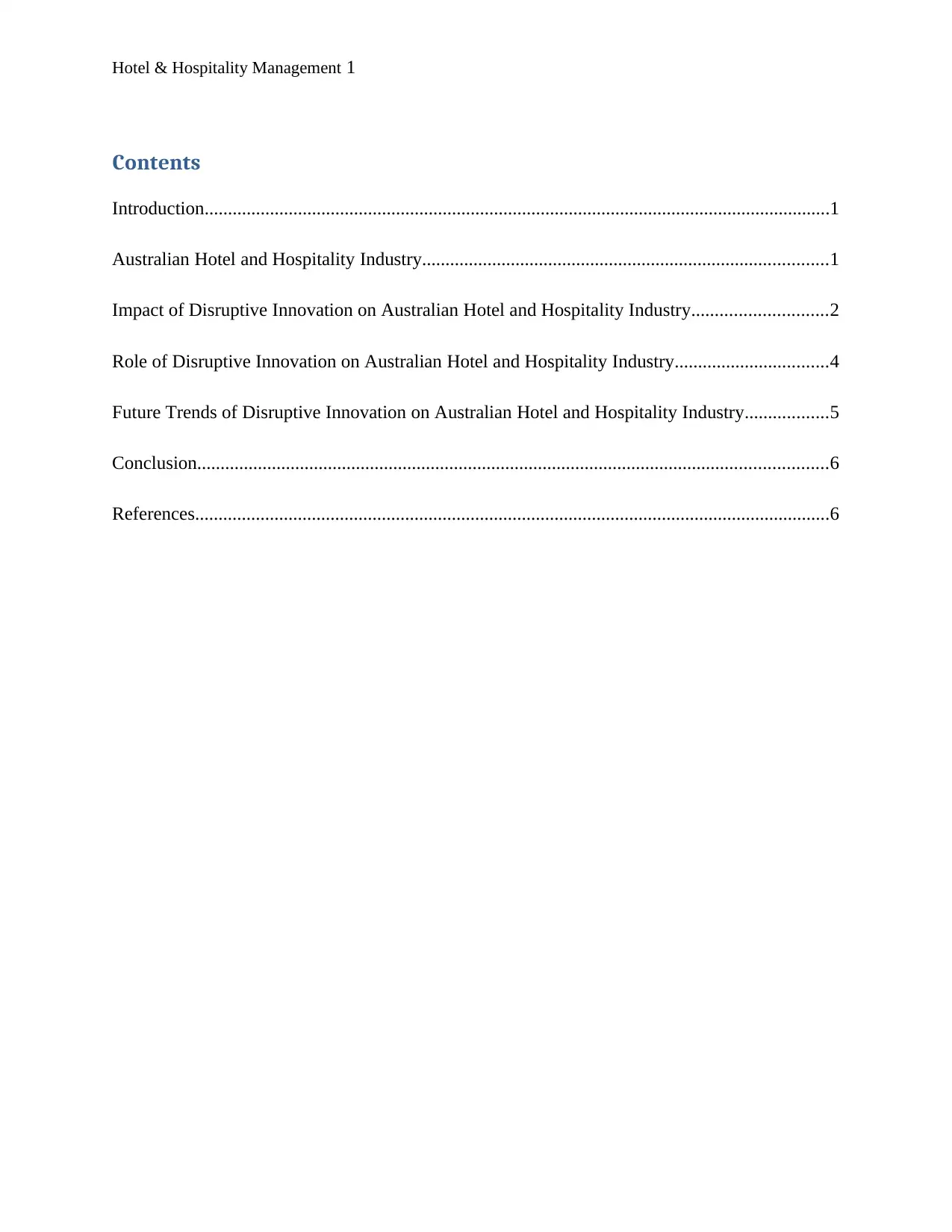
Hotel & Hospitality Management 1
Contents
Introduction......................................................................................................................................1
Australian Hotel and Hospitality Industry.......................................................................................1
Impact of Disruptive Innovation on Australian Hotel and Hospitality Industry.............................2
Role of Disruptive Innovation on Australian Hotel and Hospitality Industry.................................4
Future Trends of Disruptive Innovation on Australian Hotel and Hospitality Industry..................5
Conclusion.......................................................................................................................................6
References........................................................................................................................................6
Contents
Introduction......................................................................................................................................1
Australian Hotel and Hospitality Industry.......................................................................................1
Impact of Disruptive Innovation on Australian Hotel and Hospitality Industry.............................2
Role of Disruptive Innovation on Australian Hotel and Hospitality Industry.................................4
Future Trends of Disruptive Innovation on Australian Hotel and Hospitality Industry..................5
Conclusion.......................................................................................................................................6
References........................................................................................................................................6
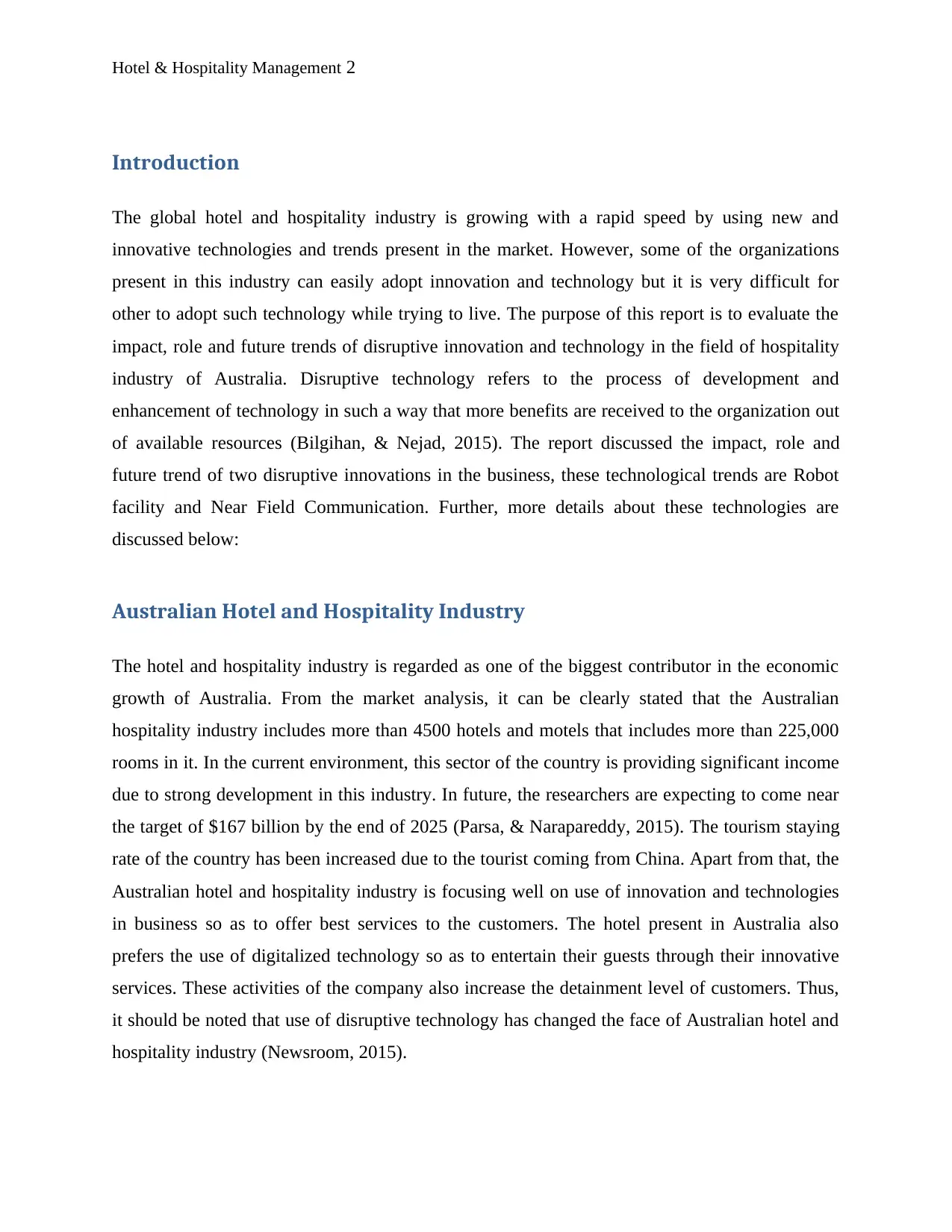
Hotel & Hospitality Management 2
Introduction
The global hotel and hospitality industry is growing with a rapid speed by using new and
innovative technologies and trends present in the market. However, some of the organizations
present in this industry can easily adopt innovation and technology but it is very difficult for
other to adopt such technology while trying to live. The purpose of this report is to evaluate the
impact, role and future trends of disruptive innovation and technology in the field of hospitality
industry of Australia. Disruptive technology refers to the process of development and
enhancement of technology in such a way that more benefits are received to the organization out
of available resources (Bilgihan, & Nejad, 2015). The report discussed the impact, role and
future trend of two disruptive innovations in the business, these technological trends are Robot
facility and Near Field Communication. Further, more details about these technologies are
discussed below:
Australian Hotel and Hospitality Industry
The hotel and hospitality industry is regarded as one of the biggest contributor in the economic
growth of Australia. From the market analysis, it can be clearly stated that the Australian
hospitality industry includes more than 4500 hotels and motels that includes more than 225,000
rooms in it. In the current environment, this sector of the country is providing significant income
due to strong development in this industry. In future, the researchers are expecting to come near
the target of $167 billion by the end of 2025 (Parsa, & Narapareddy, 2015). The tourism staying
rate of the country has been increased due to the tourist coming from China. Apart from that, the
Australian hotel and hospitality industry is focusing well on use of innovation and technologies
in business so as to offer best services to the customers. The hotel present in Australia also
prefers the use of digitalized technology so as to entertain their guests through their innovative
services. These activities of the company also increase the detainment level of customers. Thus,
it should be noted that use of disruptive technology has changed the face of Australian hotel and
hospitality industry (Newsroom, 2015).
Introduction
The global hotel and hospitality industry is growing with a rapid speed by using new and
innovative technologies and trends present in the market. However, some of the organizations
present in this industry can easily adopt innovation and technology but it is very difficult for
other to adopt such technology while trying to live. The purpose of this report is to evaluate the
impact, role and future trends of disruptive innovation and technology in the field of hospitality
industry of Australia. Disruptive technology refers to the process of development and
enhancement of technology in such a way that more benefits are received to the organization out
of available resources (Bilgihan, & Nejad, 2015). The report discussed the impact, role and
future trend of two disruptive innovations in the business, these technological trends are Robot
facility and Near Field Communication. Further, more details about these technologies are
discussed below:
Australian Hotel and Hospitality Industry
The hotel and hospitality industry is regarded as one of the biggest contributor in the economic
growth of Australia. From the market analysis, it can be clearly stated that the Australian
hospitality industry includes more than 4500 hotels and motels that includes more than 225,000
rooms in it. In the current environment, this sector of the country is providing significant income
due to strong development in this industry. In future, the researchers are expecting to come near
the target of $167 billion by the end of 2025 (Parsa, & Narapareddy, 2015). The tourism staying
rate of the country has been increased due to the tourist coming from China. Apart from that, the
Australian hotel and hospitality industry is focusing well on use of innovation and technologies
in business so as to offer best services to the customers. The hotel present in Australia also
prefers the use of digitalized technology so as to entertain their guests through their innovative
services. These activities of the company also increase the detainment level of customers. Thus,
it should be noted that use of disruptive technology has changed the face of Australian hotel and
hospitality industry (Newsroom, 2015).
⊘ This is a preview!⊘
Do you want full access?
Subscribe today to unlock all pages.

Trusted by 1+ million students worldwide
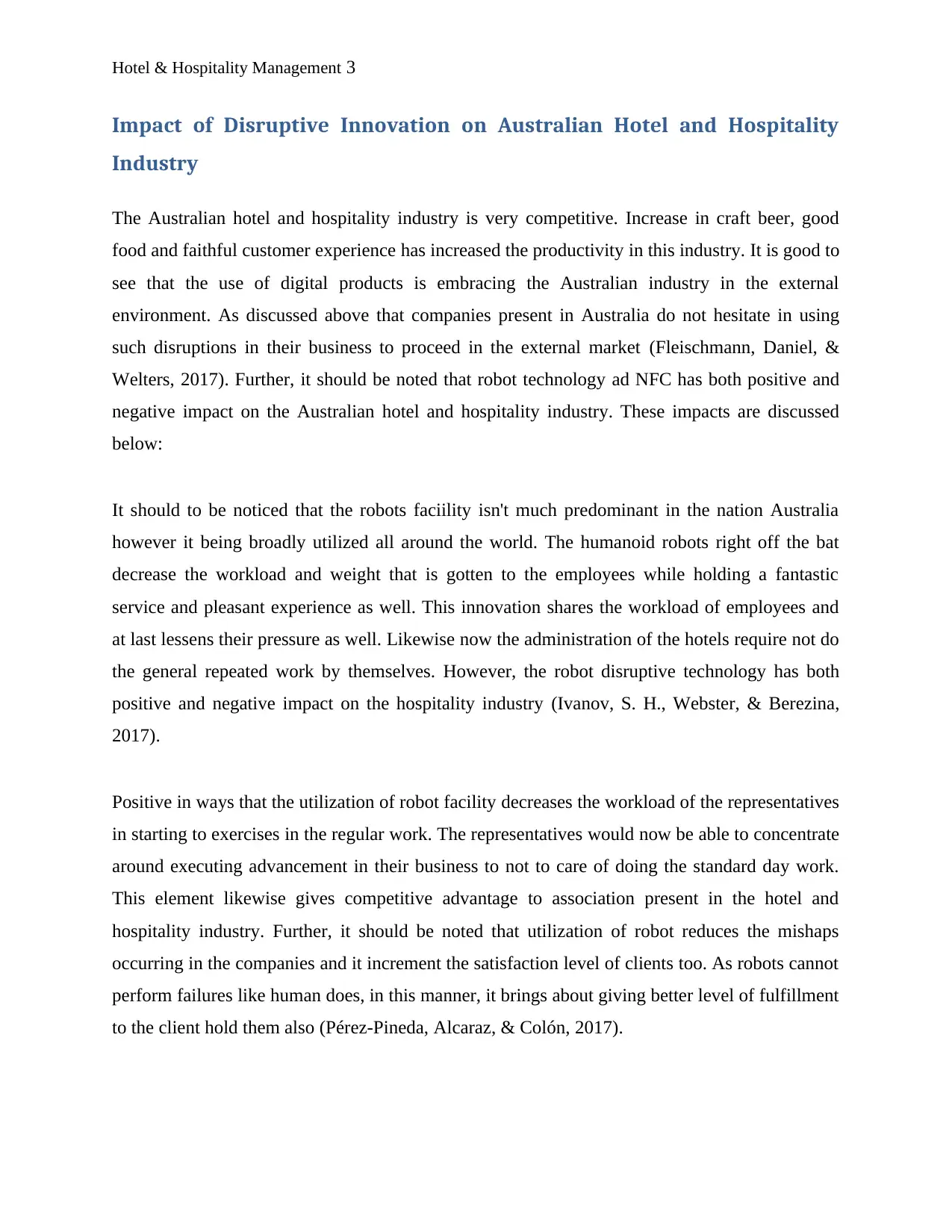
Hotel & Hospitality Management 3
Impact of Disruptive Innovation on Australian Hotel and Hospitality
Industry
The Australian hotel and hospitality industry is very competitive. Increase in craft beer, good
food and faithful customer experience has increased the productivity in this industry. It is good to
see that the use of digital products is embracing the Australian industry in the external
environment. As discussed above that companies present in Australia do not hesitate in using
such disruptions in their business to proceed in the external market (Fleischmann, Daniel, &
Welters, 2017). Further, it should be noted that robot technology ad NFC has both positive and
negative impact on the Australian hotel and hospitality industry. These impacts are discussed
below:
It should to be noticed that the robots faciility isn't much predominant in the nation Australia
however it being broadly utilized all around the world. The humanoid robots right off the bat
decrease the workload and weight that is gotten to the employees while holding a fantastic
service and pleasant experience as well. This innovation shares the workload of employees and
at last lessens their pressure as well. Likewise now the administration of the hotels require not do
the general repeated work by themselves. However, the robot disruptive technology has both
positive and negative impact on the hospitality industry (Ivanov, S. H., Webster, & Berezina,
2017).
Positive in ways that the utilization of robot facility decreases the workload of the representatives
in starting to exercises in the regular work. The representatives would now be able to concentrate
around executing advancement in their business to not to care of doing the standard day work.
This element likewise gives competitive advantage to association present in the hotel and
hospitality industry. Further, it should be noted that utilization of robot reduces the mishaps
occurring in the companies and it increment the satisfaction level of clients too. As robots cannot
perform failures like human does, in this manner, it brings about giving better level of fulfillment
to the client hold them also (Pérez-Pineda, Alcaraz, & Colón, 2017).
Impact of Disruptive Innovation on Australian Hotel and Hospitality
Industry
The Australian hotel and hospitality industry is very competitive. Increase in craft beer, good
food and faithful customer experience has increased the productivity in this industry. It is good to
see that the use of digital products is embracing the Australian industry in the external
environment. As discussed above that companies present in Australia do not hesitate in using
such disruptions in their business to proceed in the external market (Fleischmann, Daniel, &
Welters, 2017). Further, it should be noted that robot technology ad NFC has both positive and
negative impact on the Australian hotel and hospitality industry. These impacts are discussed
below:
It should to be noticed that the robots faciility isn't much predominant in the nation Australia
however it being broadly utilized all around the world. The humanoid robots right off the bat
decrease the workload and weight that is gotten to the employees while holding a fantastic
service and pleasant experience as well. This innovation shares the workload of employees and
at last lessens their pressure as well. Likewise now the administration of the hotels require not do
the general repeated work by themselves. However, the robot disruptive technology has both
positive and negative impact on the hospitality industry (Ivanov, S. H., Webster, & Berezina,
2017).
Positive in ways that the utilization of robot facility decreases the workload of the representatives
in starting to exercises in the regular work. The representatives would now be able to concentrate
around executing advancement in their business to not to care of doing the standard day work.
This element likewise gives competitive advantage to association present in the hotel and
hospitality industry. Further, it should be noted that utilization of robot reduces the mishaps
occurring in the companies and it increment the satisfaction level of clients too. As robots cannot
perform failures like human does, in this manner, it brings about giving better level of fulfillment
to the client hold them also (Pérez-Pineda, Alcaraz, & Colón, 2017).
Paraphrase This Document
Need a fresh take? Get an instant paraphrase of this document with our AI Paraphraser
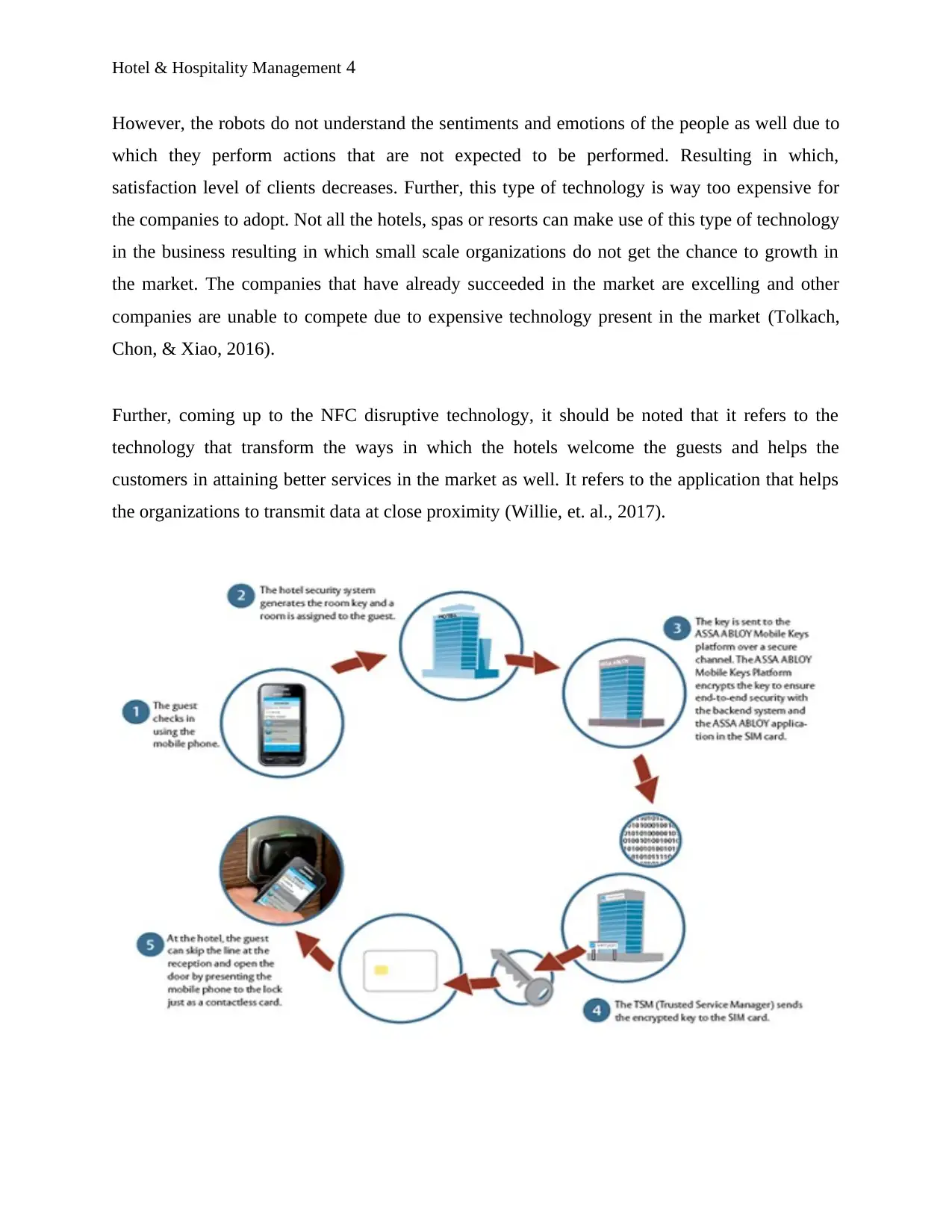
Hotel & Hospitality Management 4
However, the robots do not understand the sentiments and emotions of the people as well due to
which they perform actions that are not expected to be performed. Resulting in which,
satisfaction level of clients decreases. Further, this type of technology is way too expensive for
the companies to adopt. Not all the hotels, spas or resorts can make use of this type of technology
in the business resulting in which small scale organizations do not get the chance to growth in
the market. The companies that have already succeeded in the market are excelling and other
companies are unable to compete due to expensive technology present in the market (Tolkach,
Chon, & Xiao, 2016).
Further, coming up to the NFC disruptive technology, it should be noted that it refers to the
technology that transform the ways in which the hotels welcome the guests and helps the
customers in attaining better services in the market as well. It refers to the application that helps
the organizations to transmit data at close proximity (Willie, et. al., 2017).
However, the robots do not understand the sentiments and emotions of the people as well due to
which they perform actions that are not expected to be performed. Resulting in which,
satisfaction level of clients decreases. Further, this type of technology is way too expensive for
the companies to adopt. Not all the hotels, spas or resorts can make use of this type of technology
in the business resulting in which small scale organizations do not get the chance to growth in
the market. The companies that have already succeeded in the market are excelling and other
companies are unable to compete due to expensive technology present in the market (Tolkach,
Chon, & Xiao, 2016).
Further, coming up to the NFC disruptive technology, it should be noted that it refers to the
technology that transform the ways in which the hotels welcome the guests and helps the
customers in attaining better services in the market as well. It refers to the application that helps
the organizations to transmit data at close proximity (Willie, et. al., 2017).
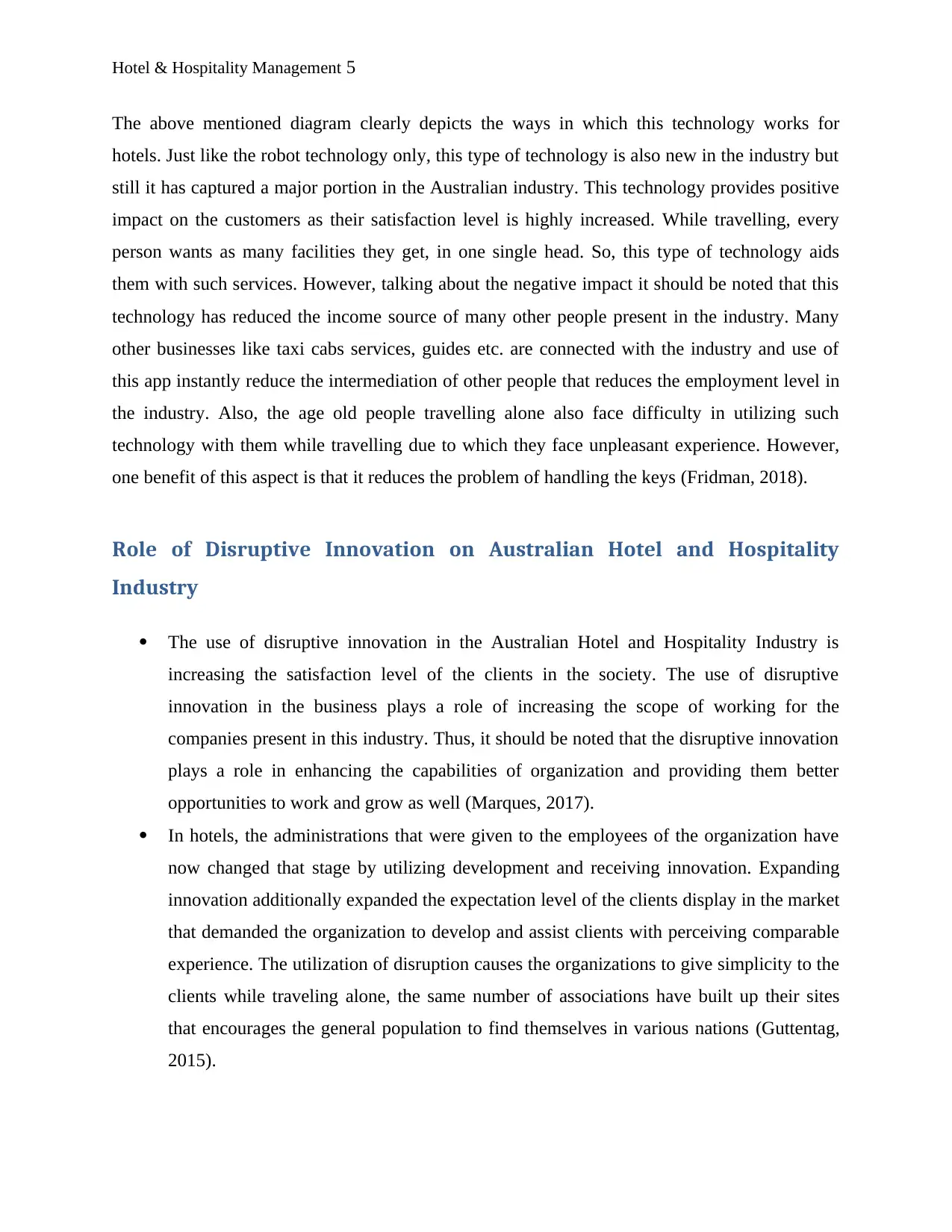
Hotel & Hospitality Management 5
The above mentioned diagram clearly depicts the ways in which this technology works for
hotels. Just like the robot technology only, this type of technology is also new in the industry but
still it has captured a major portion in the Australian industry. This technology provides positive
impact on the customers as their satisfaction level is highly increased. While travelling, every
person wants as many facilities they get, in one single head. So, this type of technology aids
them with such services. However, talking about the negative impact it should be noted that this
technology has reduced the income source of many other people present in the industry. Many
other businesses like taxi cabs services, guides etc. are connected with the industry and use of
this app instantly reduce the intermediation of other people that reduces the employment level in
the industry. Also, the age old people travelling alone also face difficulty in utilizing such
technology with them while travelling due to which they face unpleasant experience. However,
one benefit of this aspect is that it reduces the problem of handling the keys (Fridman, 2018).
Role of Disruptive Innovation on Australian Hotel and Hospitality
Industry
The use of disruptive innovation in the Australian Hotel and Hospitality Industry is
increasing the satisfaction level of the clients in the society. The use of disruptive
innovation in the business plays a role of increasing the scope of working for the
companies present in this industry. Thus, it should be noted that the disruptive innovation
plays a role in enhancing the capabilities of organization and providing them better
opportunities to work and grow as well (Marques, 2017).
In hotels, the administrations that were given to the employees of the organization have
now changed that stage by utilizing development and receiving innovation. Expanding
innovation additionally expanded the expectation level of the clients display in the market
that demanded the organization to develop and assist clients with perceiving comparable
experience. The utilization of disruption causes the organizations to give simplicity to the
clients while traveling alone, the same number of associations have built up their sites
that encourages the general population to find themselves in various nations (Guttentag,
2015).
The above mentioned diagram clearly depicts the ways in which this technology works for
hotels. Just like the robot technology only, this type of technology is also new in the industry but
still it has captured a major portion in the Australian industry. This technology provides positive
impact on the customers as their satisfaction level is highly increased. While travelling, every
person wants as many facilities they get, in one single head. So, this type of technology aids
them with such services. However, talking about the negative impact it should be noted that this
technology has reduced the income source of many other people present in the industry. Many
other businesses like taxi cabs services, guides etc. are connected with the industry and use of
this app instantly reduce the intermediation of other people that reduces the employment level in
the industry. Also, the age old people travelling alone also face difficulty in utilizing such
technology with them while travelling due to which they face unpleasant experience. However,
one benefit of this aspect is that it reduces the problem of handling the keys (Fridman, 2018).
Role of Disruptive Innovation on Australian Hotel and Hospitality
Industry
The use of disruptive innovation in the Australian Hotel and Hospitality Industry is
increasing the satisfaction level of the clients in the society. The use of disruptive
innovation in the business plays a role of increasing the scope of working for the
companies present in this industry. Thus, it should be noted that the disruptive innovation
plays a role in enhancing the capabilities of organization and providing them better
opportunities to work and grow as well (Marques, 2017).
In hotels, the administrations that were given to the employees of the organization have
now changed that stage by utilizing development and receiving innovation. Expanding
innovation additionally expanded the expectation level of the clients display in the market
that demanded the organization to develop and assist clients with perceiving comparable
experience. The utilization of disruption causes the organizations to give simplicity to the
clients while traveling alone, the same number of associations have built up their sites
that encourages the general population to find themselves in various nations (Guttentag,
2015).
⊘ This is a preview!⊘
Do you want full access?
Subscribe today to unlock all pages.

Trusted by 1+ million students worldwide
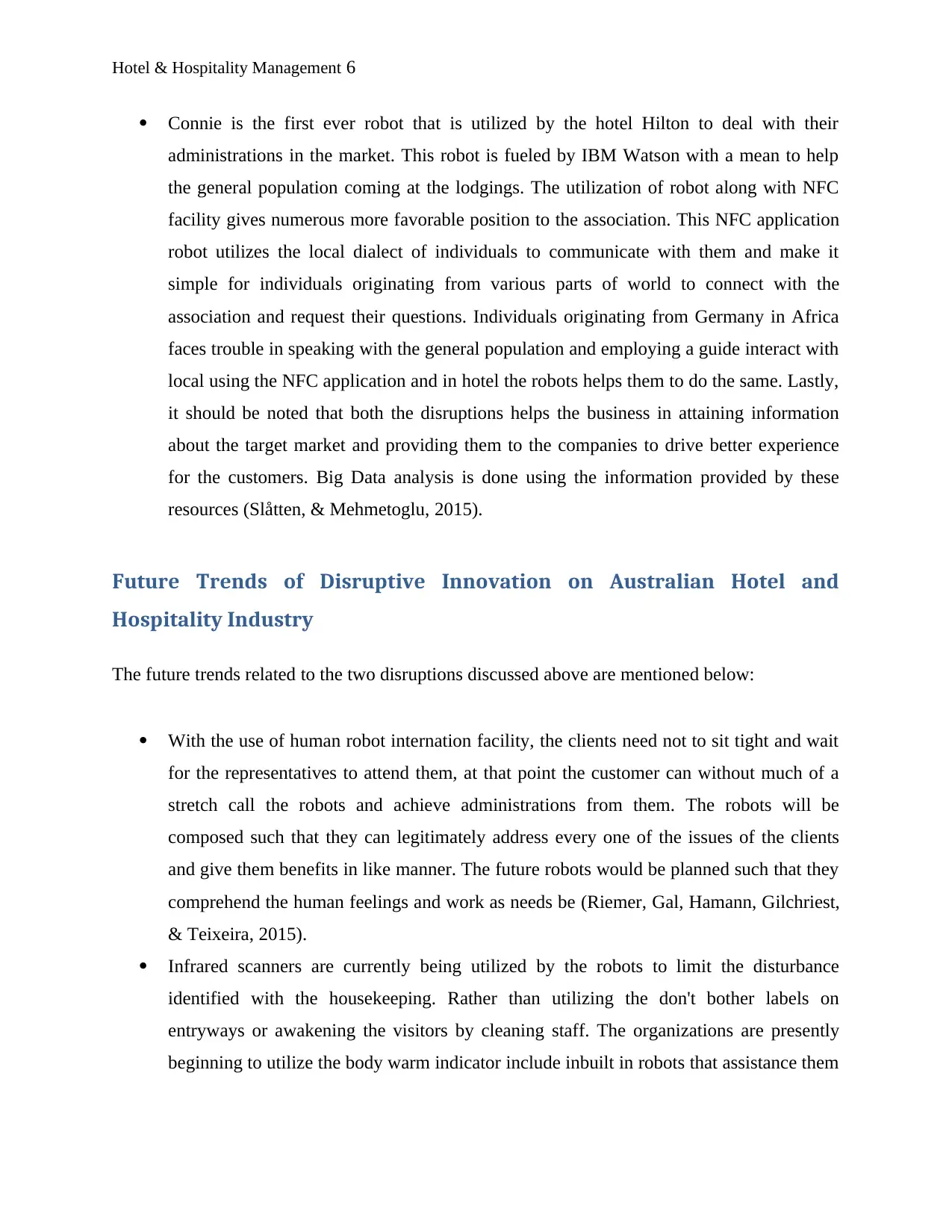
Hotel & Hospitality Management 6
Connie is the first ever robot that is utilized by the hotel Hilton to deal with their
administrations in the market. This robot is fueled by IBM Watson with a mean to help
the general population coming at the lodgings. The utilization of robot along with NFC
facility gives numerous more favorable position to the association. This NFC application
robot utilizes the local dialect of individuals to communicate with them and make it
simple for individuals originating from various parts of world to connect with the
association and request their questions. Individuals originating from Germany in Africa
faces trouble in speaking with the general population and employing a guide interact with
local using the NFC application and in hotel the robots helps them to do the same. Lastly,
it should be noted that both the disruptions helps the business in attaining information
about the target market and providing them to the companies to drive better experience
for the customers. Big Data analysis is done using the information provided by these
resources (Slåtten, & Mehmetoglu, 2015).
Future Trends of Disruptive Innovation on Australian Hotel and
Hospitality Industry
The future trends related to the two disruptions discussed above are mentioned below:
With the use of human robot internation facility, the clients need not to sit tight and wait
for the representatives to attend them, at that point the customer can without much of a
stretch call the robots and achieve administrations from them. The robots will be
composed such that they can legitimately address every one of the issues of the clients
and give them benefits in like manner. The future robots would be planned such that they
comprehend the human feelings and work as needs be (Riemer, Gal, Hamann, Gilchriest,
& Teixeira, 2015).
Infrared scanners are currently being utilized by the robots to limit the disturbance
identified with the housekeeping. Rather than utilizing the don't bother labels on
entryways or awakening the visitors by cleaning staff. The organizations are presently
beginning to utilize the body warm indicator include inbuilt in robots that assistance them
Connie is the first ever robot that is utilized by the hotel Hilton to deal with their
administrations in the market. This robot is fueled by IBM Watson with a mean to help
the general population coming at the lodgings. The utilization of robot along with NFC
facility gives numerous more favorable position to the association. This NFC application
robot utilizes the local dialect of individuals to communicate with them and make it
simple for individuals originating from various parts of world to connect with the
association and request their questions. Individuals originating from Germany in Africa
faces trouble in speaking with the general population and employing a guide interact with
local using the NFC application and in hotel the robots helps them to do the same. Lastly,
it should be noted that both the disruptions helps the business in attaining information
about the target market and providing them to the companies to drive better experience
for the customers. Big Data analysis is done using the information provided by these
resources (Slåtten, & Mehmetoglu, 2015).
Future Trends of Disruptive Innovation on Australian Hotel and
Hospitality Industry
The future trends related to the two disruptions discussed above are mentioned below:
With the use of human robot internation facility, the clients need not to sit tight and wait
for the representatives to attend them, at that point the customer can without much of a
stretch call the robots and achieve administrations from them. The robots will be
composed such that they can legitimately address every one of the issues of the clients
and give them benefits in like manner. The future robots would be planned such that they
comprehend the human feelings and work as needs be (Riemer, Gal, Hamann, Gilchriest,
& Teixeira, 2015).
Infrared scanners are currently being utilized by the robots to limit the disturbance
identified with the housekeeping. Rather than utilizing the don't bother labels on
entryways or awakening the visitors by cleaning staff. The organizations are presently
beginning to utilize the body warm indicator include inbuilt in robots that assistance them
Paraphrase This Document
Need a fresh take? Get an instant paraphrase of this document with our AI Paraphraser
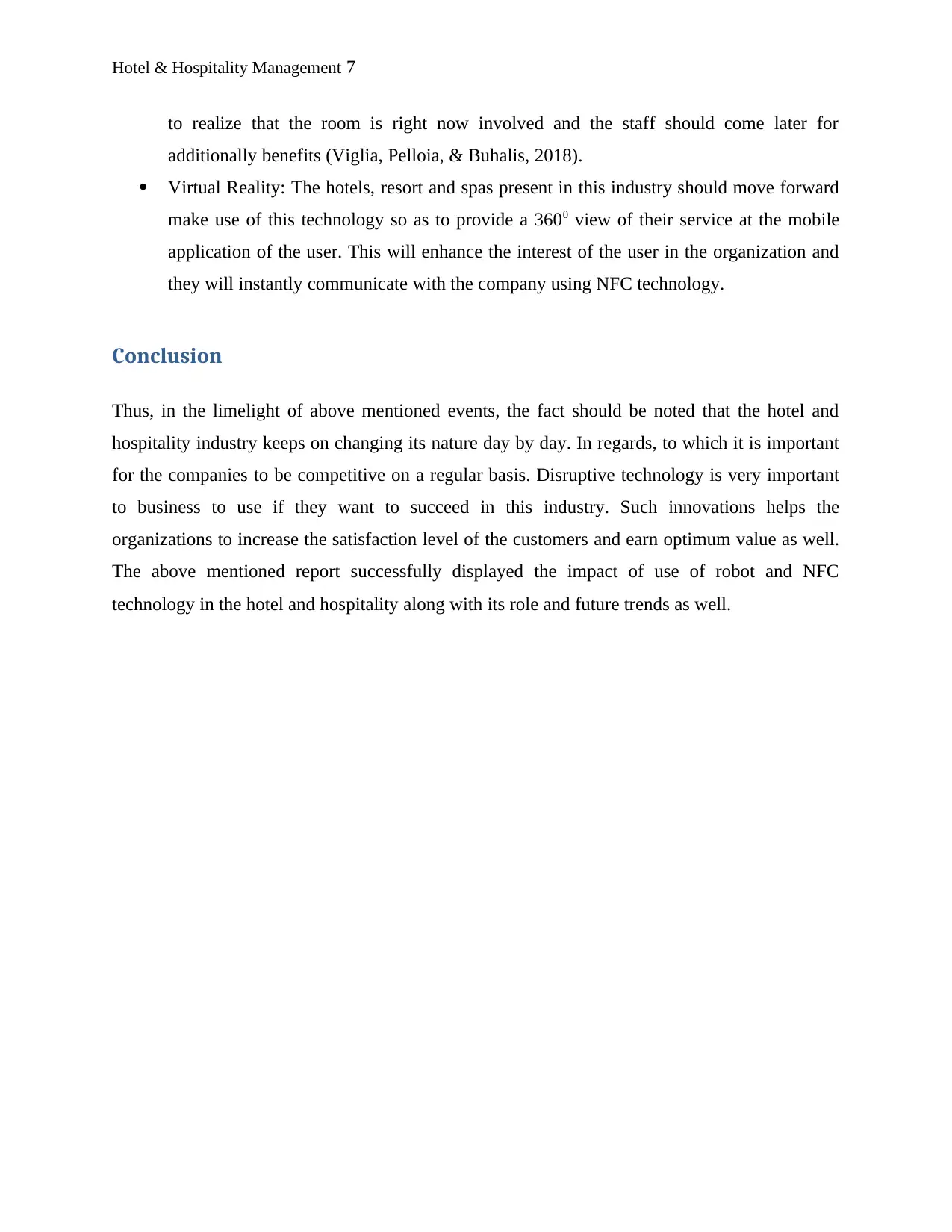
Hotel & Hospitality Management 7
to realize that the room is right now involved and the staff should come later for
additionally benefits (Viglia, Pelloia, & Buhalis, 2018).
Virtual Reality: The hotels, resort and spas present in this industry should move forward
make use of this technology so as to provide a 3600 view of their service at the mobile
application of the user. This will enhance the interest of the user in the organization and
they will instantly communicate with the company using NFC technology.
Conclusion
Thus, in the limelight of above mentioned events, the fact should be noted that the hotel and
hospitality industry keeps on changing its nature day by day. In regards, to which it is important
for the companies to be competitive on a regular basis. Disruptive technology is very important
to business to use if they want to succeed in this industry. Such innovations helps the
organizations to increase the satisfaction level of the customers and earn optimum value as well.
The above mentioned report successfully displayed the impact of use of robot and NFC
technology in the hotel and hospitality along with its role and future trends as well.
to realize that the room is right now involved and the staff should come later for
additionally benefits (Viglia, Pelloia, & Buhalis, 2018).
Virtual Reality: The hotels, resort and spas present in this industry should move forward
make use of this technology so as to provide a 3600 view of their service at the mobile
application of the user. This will enhance the interest of the user in the organization and
they will instantly communicate with the company using NFC technology.
Conclusion
Thus, in the limelight of above mentioned events, the fact should be noted that the hotel and
hospitality industry keeps on changing its nature day by day. In regards, to which it is important
for the companies to be competitive on a regular basis. Disruptive technology is very important
to business to use if they want to succeed in this industry. Such innovations helps the
organizations to increase the satisfaction level of the customers and earn optimum value as well.
The above mentioned report successfully displayed the impact of use of robot and NFC
technology in the hotel and hospitality along with its role and future trends as well.
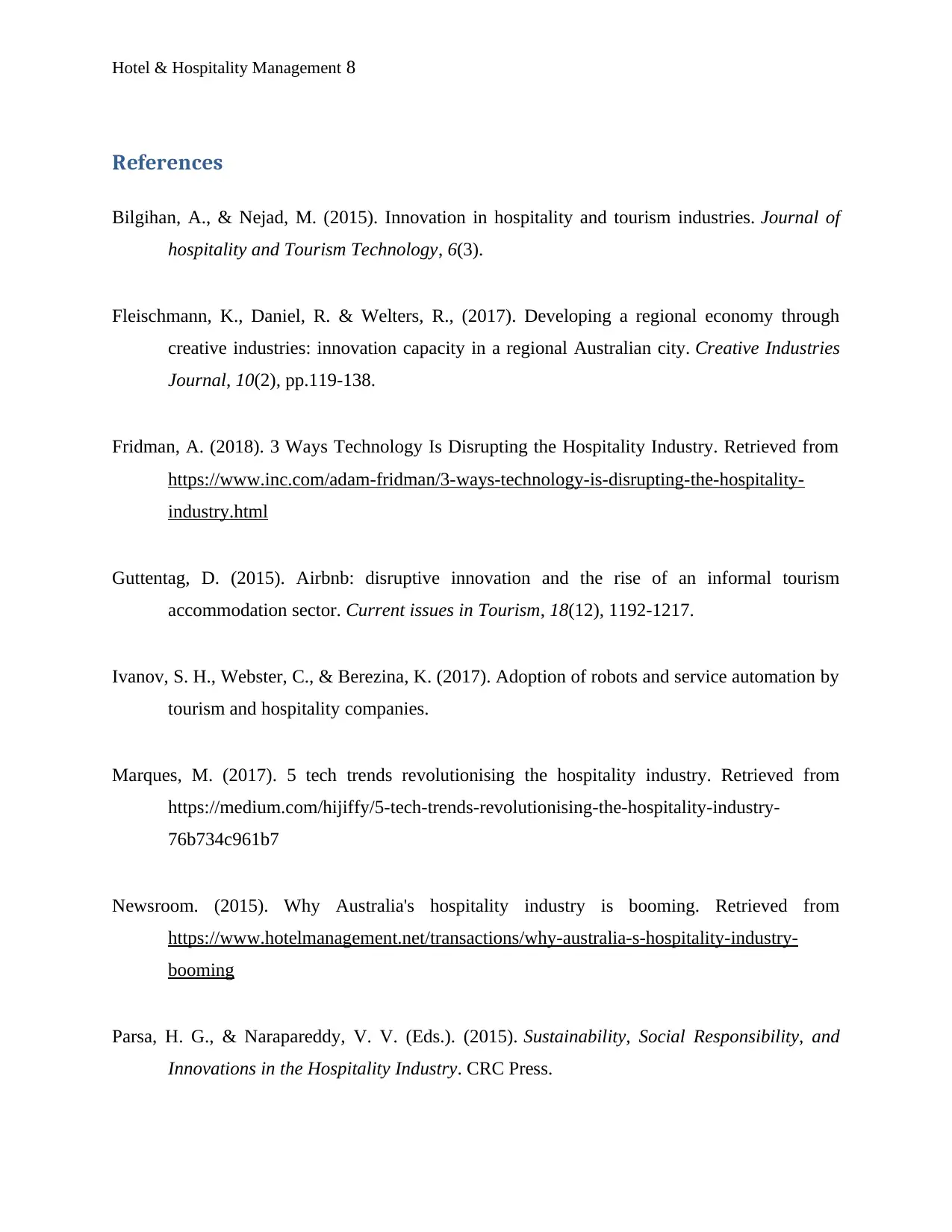
Hotel & Hospitality Management 8
References
Bilgihan, A., & Nejad, M. (2015). Innovation in hospitality and tourism industries. Journal of
hospitality and Tourism Technology, 6(3).
Fleischmann, K., Daniel, R. & Welters, R., (2017). Developing a regional economy through
creative industries: innovation capacity in a regional Australian city. Creative Industries
Journal, 10(2), pp.119-138.
Fridman, A. (2018). 3 Ways Technology Is Disrupting the Hospitality Industry. Retrieved from
https://www.inc.com/adam-fridman/3-ways-technology-is-disrupting-the-hospitality-
industry.html
Guttentag, D. (2015). Airbnb: disruptive innovation and the rise of an informal tourism
accommodation sector. Current issues in Tourism, 18(12), 1192-1217.
Ivanov, S. H., Webster, C., & Berezina, K. (2017). Adoption of robots and service automation by
tourism and hospitality companies.
Marques, M. (2017). 5 tech trends revolutionising the hospitality industry. Retrieved from
https://medium.com/hijiffy/5-tech-trends-revolutionising-the-hospitality-industry-
76b734c961b7
Newsroom. (2015). Why Australia's hospitality industry is booming. Retrieved from
https://www.hotelmanagement.net/transactions/why-australia-s-hospitality-industry-
booming
Parsa, H. G., & Narapareddy, V. V. (Eds.). (2015). Sustainability, Social Responsibility, and
Innovations in the Hospitality Industry. CRC Press.
References
Bilgihan, A., & Nejad, M. (2015). Innovation in hospitality and tourism industries. Journal of
hospitality and Tourism Technology, 6(3).
Fleischmann, K., Daniel, R. & Welters, R., (2017). Developing a regional economy through
creative industries: innovation capacity in a regional Australian city. Creative Industries
Journal, 10(2), pp.119-138.
Fridman, A. (2018). 3 Ways Technology Is Disrupting the Hospitality Industry. Retrieved from
https://www.inc.com/adam-fridman/3-ways-technology-is-disrupting-the-hospitality-
industry.html
Guttentag, D. (2015). Airbnb: disruptive innovation and the rise of an informal tourism
accommodation sector. Current issues in Tourism, 18(12), 1192-1217.
Ivanov, S. H., Webster, C., & Berezina, K. (2017). Adoption of robots and service automation by
tourism and hospitality companies.
Marques, M. (2017). 5 tech trends revolutionising the hospitality industry. Retrieved from
https://medium.com/hijiffy/5-tech-trends-revolutionising-the-hospitality-industry-
76b734c961b7
Newsroom. (2015). Why Australia's hospitality industry is booming. Retrieved from
https://www.hotelmanagement.net/transactions/why-australia-s-hospitality-industry-
booming
Parsa, H. G., & Narapareddy, V. V. (Eds.). (2015). Sustainability, Social Responsibility, and
Innovations in the Hospitality Industry. CRC Press.
⊘ This is a preview!⊘
Do you want full access?
Subscribe today to unlock all pages.

Trusted by 1+ million students worldwide
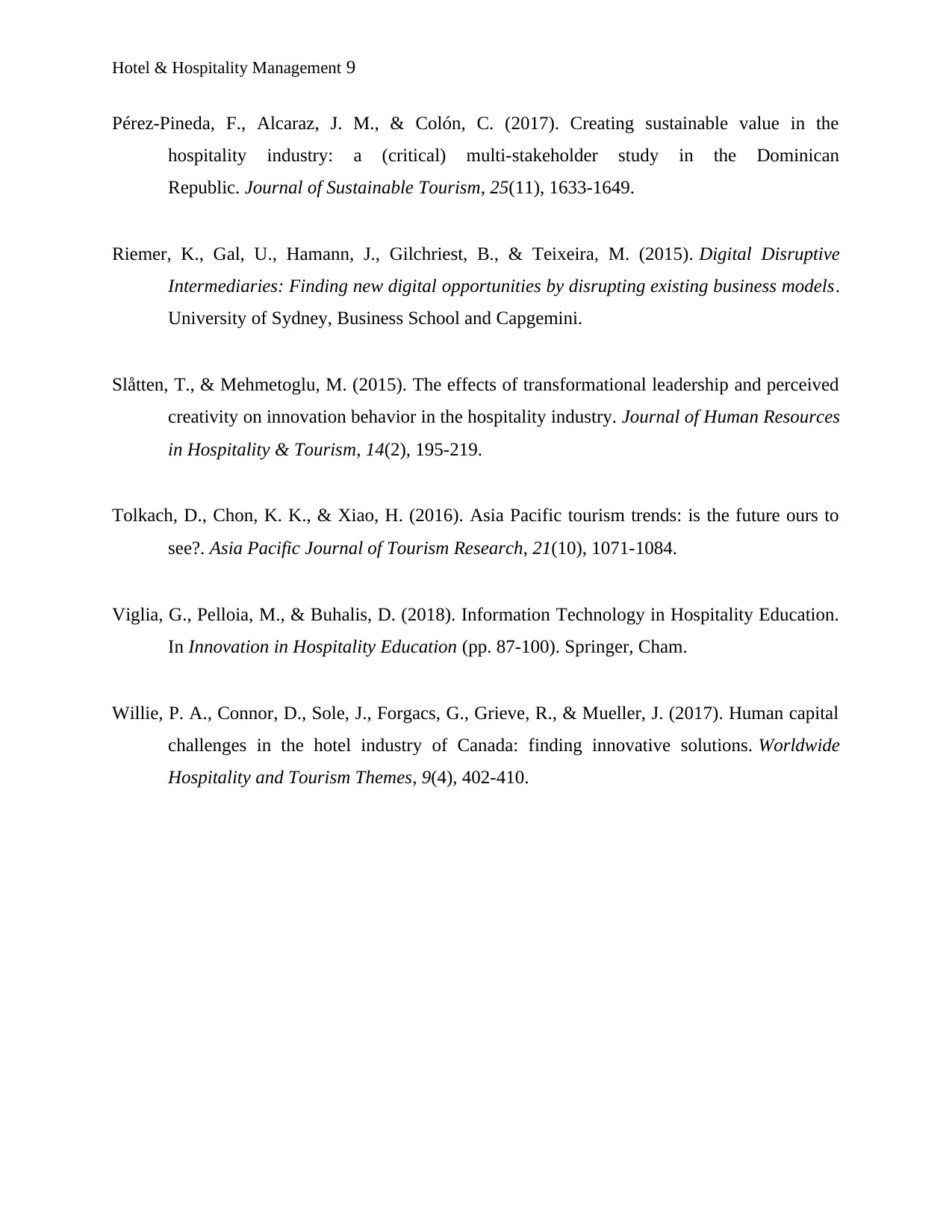
Hotel & Hospitality Management 9
Pérez-Pineda, F., Alcaraz, J. M., & Colón, C. (2017). Creating sustainable value in the
hospitality industry: a (critical) multi-stakeholder study in the Dominican
Republic. Journal of Sustainable Tourism, 25(11), 1633-1649.
Riemer, K., Gal, U., Hamann, J., Gilchriest, B., & Teixeira, M. (2015). Digital Disruptive
Intermediaries: Finding new digital opportunities by disrupting existing business models.
University of Sydney, Business School and Capgemini.
Slåtten, T., & Mehmetoglu, M. (2015). The effects of transformational leadership and perceived
creativity on innovation behavior in the hospitality industry. Journal of Human Resources
in Hospitality & Tourism, 14(2), 195-219.
Tolkach, D., Chon, K. K., & Xiao, H. (2016). Asia Pacific tourism trends: is the future ours to
see?. Asia Pacific Journal of Tourism Research, 21(10), 1071-1084.
Viglia, G., Pelloia, M., & Buhalis, D. (2018). Information Technology in Hospitality Education.
In Innovation in Hospitality Education (pp. 87-100). Springer, Cham.
Willie, P. A., Connor, D., Sole, J., Forgacs, G., Grieve, R., & Mueller, J. (2017). Human capital
challenges in the hotel industry of Canada: finding innovative solutions. Worldwide
Hospitality and Tourism Themes, 9(4), 402-410.
Pérez-Pineda, F., Alcaraz, J. M., & Colón, C. (2017). Creating sustainable value in the
hospitality industry: a (critical) multi-stakeholder study in the Dominican
Republic. Journal of Sustainable Tourism, 25(11), 1633-1649.
Riemer, K., Gal, U., Hamann, J., Gilchriest, B., & Teixeira, M. (2015). Digital Disruptive
Intermediaries: Finding new digital opportunities by disrupting existing business models.
University of Sydney, Business School and Capgemini.
Slåtten, T., & Mehmetoglu, M. (2015). The effects of transformational leadership and perceived
creativity on innovation behavior in the hospitality industry. Journal of Human Resources
in Hospitality & Tourism, 14(2), 195-219.
Tolkach, D., Chon, K. K., & Xiao, H. (2016). Asia Pacific tourism trends: is the future ours to
see?. Asia Pacific Journal of Tourism Research, 21(10), 1071-1084.
Viglia, G., Pelloia, M., & Buhalis, D. (2018). Information Technology in Hospitality Education.
In Innovation in Hospitality Education (pp. 87-100). Springer, Cham.
Willie, P. A., Connor, D., Sole, J., Forgacs, G., Grieve, R., & Mueller, J. (2017). Human capital
challenges in the hotel industry of Canada: finding innovative solutions. Worldwide
Hospitality and Tourism Themes, 9(4), 402-410.
1 out of 10
Related Documents
Your All-in-One AI-Powered Toolkit for Academic Success.
+13062052269
info@desklib.com
Available 24*7 on WhatsApp / Email
![[object Object]](/_next/static/media/star-bottom.7253800d.svg)
Unlock your academic potential
Copyright © 2020–2025 A2Z Services. All Rights Reserved. Developed and managed by ZUCOL.




